Overview
This article highlights ten essential behaviors of autism that every parent should be aware of, emphasizing the crucial role of awareness and proactive support strategies for children on the spectrum. By shedding light on behaviors such as social communication challenges, restricted and repetitive actions, sensory processing differences, and emotional regulation issues, it becomes clear that early recognition and tailored interventions can profoundly enhance the development and well-being of autistic children.
As parents, understanding these behaviors is not just about recognizing differences; it’s about fostering an environment where your child can thrive. Imagine the peace of mind that comes from knowing how to support your child effectively.
Consider the challenges your child may face in social situations. These moments can be overwhelming, and knowing how to navigate them can make all the difference. By sharing experiences and strategies, we can create a supportive community that uplifts one another.
Let’s explore how early intervention can pave the way for success. With the right resources and support, you can help your child flourish. Together, we can ensure that every child on the spectrum receives the understanding and encouragement they deserve.
Introduction
Navigating the complexities of autism can feel overwhelming for parents and caregivers. However, a wealth of resources is available to illuminate this challenging path.
ASD Media is dedicated to supporting families and professionals, offering comprehensive tools designed to empower them. From insightful articles that unpack autism behaviors to interactive webinars and supportive community forums, these resources foster understanding and effective intervention strategies.
With the rising prevalence of Autism Spectrum Disorder highlighted by recent statistics, the need for accessible information has never been more critical. By exploring the offerings of ASD Media, individuals can gain valuable insights into the unique challenges of autism, enabling them to implement strategies that promote development and well-being.
This article delves into various aspects of autism, including social communication challenges and sensory processing differences, providing a holistic view aimed at enhancing the lives of those affected by this condition.
ASD Media: Comprehensive Resources for Understanding Autism Behaviors
At ASD Media, we understand the journey parents and professionals face when navigating the complexities of autism. Our wide range of resources, including informative articles, engaging webinars, and supportive community forums, is designed to help you explore the behaviors of autism and effective intervention strategies. Did you know that studies show approximately 1 in 6 youths aged 3–17 years were identified with a developmental disability from 2009 to 2017? This statistic highlights the urgent need for accessible information and support.
Moreover, a case study from the CDC revealed that the occurrence of Autism Spectrum Disorder (ASD) among 8-year-olds was 27.6 per 1,000 youths, with boys significantly more impacted than girls. This emphasizes the necessity for focused interventions and resources tailored to various demographic groups. As Kyle Coddington, CEO of Prospera Healthcare, eloquently states, "Personalized, in-home ABA therapy to assist youngsters with developmental disorders across Texas build lasting skills and thrive."
By engaging with ASD Media's offerings, families can gain a deeper understanding of the unique challenges associated with the behaviors of autism. This knowledge empowers you to implement effective strategies that foster your children's development and well-being. Our community forums play a crucial role in providing peer assistance, allowing parents to share experiences and solutions, which can greatly enhance your ability to navigate the landscape of autism-related issues.
We invite you to explore ASD Media's resources and community forums for the support and information you need. These tools can be invaluable in your journey, helping you connect with others who understand and share similar experiences.
Social Communication Challenges: Recognizing Key Indicators of Autism
Children with developmental disorders often face significant social communication challenges, which can be observed as various behaviors of autism. These difficulties in understanding both verbal and non-verbal cues, maintaining conversations, and engaging in reciprocal interactions are often associated with the behaviors of autism. For parents, recognizing key indicators such as limited eye contact, trouble interpreting facial expressions, and challenges in initiating or responding to social interactions is crucial for understanding the behaviors of autism. Early recognition of the behaviors of autism can lead to timely interventions that significantly enhance communication skills.
Statistics reveal that approximately 70% of young individuals with developmental disorders experience some form of social communication challenges. This highlights the importance of awareness and proactive assistance. Experts emphasize that tailored strategies can effectively address the behaviors of autism, fostering better social engagement and interaction. As O. Ivar Lovaas wisely stated, "If they can't learn the way we teach, we teach the way they learn," underscoring the necessity for customized methods in supporting individuals with autism.
By understanding these indicators, parents can play a pivotal role in their children's development, ensuring they receive the necessary support to thrive in social settings. It's also important to consider that some young individuals may encounter speech sound delays, which can further complicate their communication challenges. Addressing these aspects holistically can pave the way for more effective interventions and improved outcomes. If you find yourself navigating these challenges, remember that you are not alone—there are resources and communities ready to support you and your child on this journey.
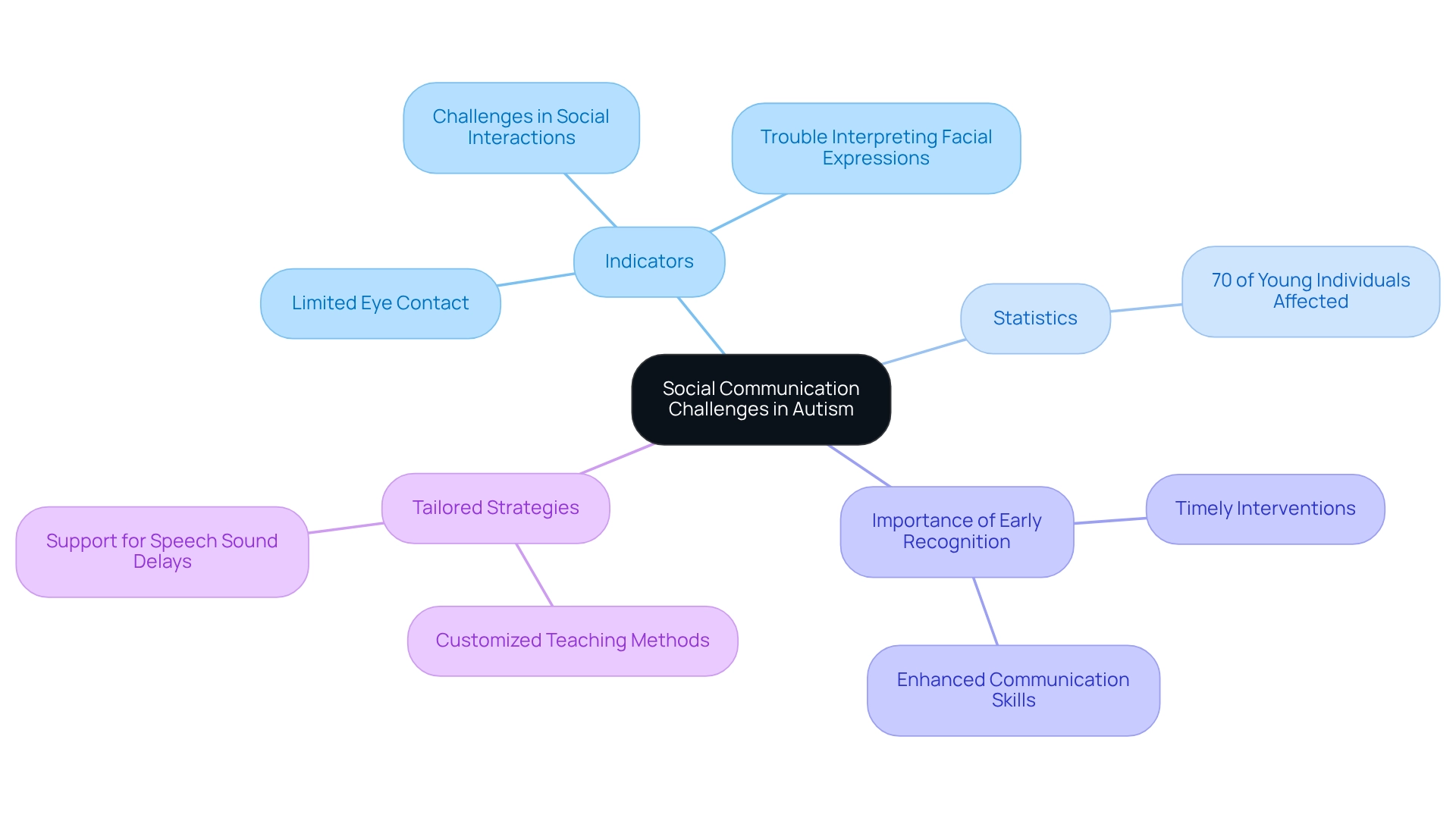
Restricted and Repetitive Behaviors: Insights into Autism Spectrum Characteristics
Restricted and repetitive behaviors of autism are defining characteristics of autism spectrum disorder (ASD), which include a range of actions such as repetitive movements, insistence on sameness, and intense focus on specific interests. While the behaviors of autism are often perceived as challenging, they serve significant functions for individuals, providing comfort, predictability, and a means of self-regulation. Recent research underscores the necessity of developing targeted intervention strategies that consider these functions.
Statistics indicate that behaviors of autism, particularly RRBs, are prevalent in roughly 90% of youth with autism, highlighting the critical need for effective management approaches. Experts emphasize that interventions should consider the unique characteristics of the behaviors of autism, as they can vary widely among individuals. For instance, a case study titled 'Behavioral Interventions for Social Skills Development' examined various behavioral interventions aimed at enhancing social skills in youth with ASD. The findings revealed that leveraging young people's circumscribed interests significantly improved their social engagement and interaction, demonstrating the potential benefits of incorporating these interests into therapeutic settings.
Moreover, the latest discoveries indicate that employing circumscribed interests in activities can improve task accuracy and social behavior in youth with ASD. This aligns with observations from psychologists, such as K. Fossum, who noted, "Using pre-treatment videos, we saw that youngsters who made the most progress exhibited more language, positive affect, and suitable interactions with toys, as well as less avoidance of people and fewer repetitive vocalizations." Understanding the fundamental functions of RRBs is essential for caregivers and professionals striving to assist young individuals effectively in managing the behaviors of autism.
To apply these insights, parents can observe their children's interests and incorporate them into daily activities, creating opportunities for engagement and reducing the intensity of RRBs. This approach not only fosters connection but also enhances the overall development of the child.
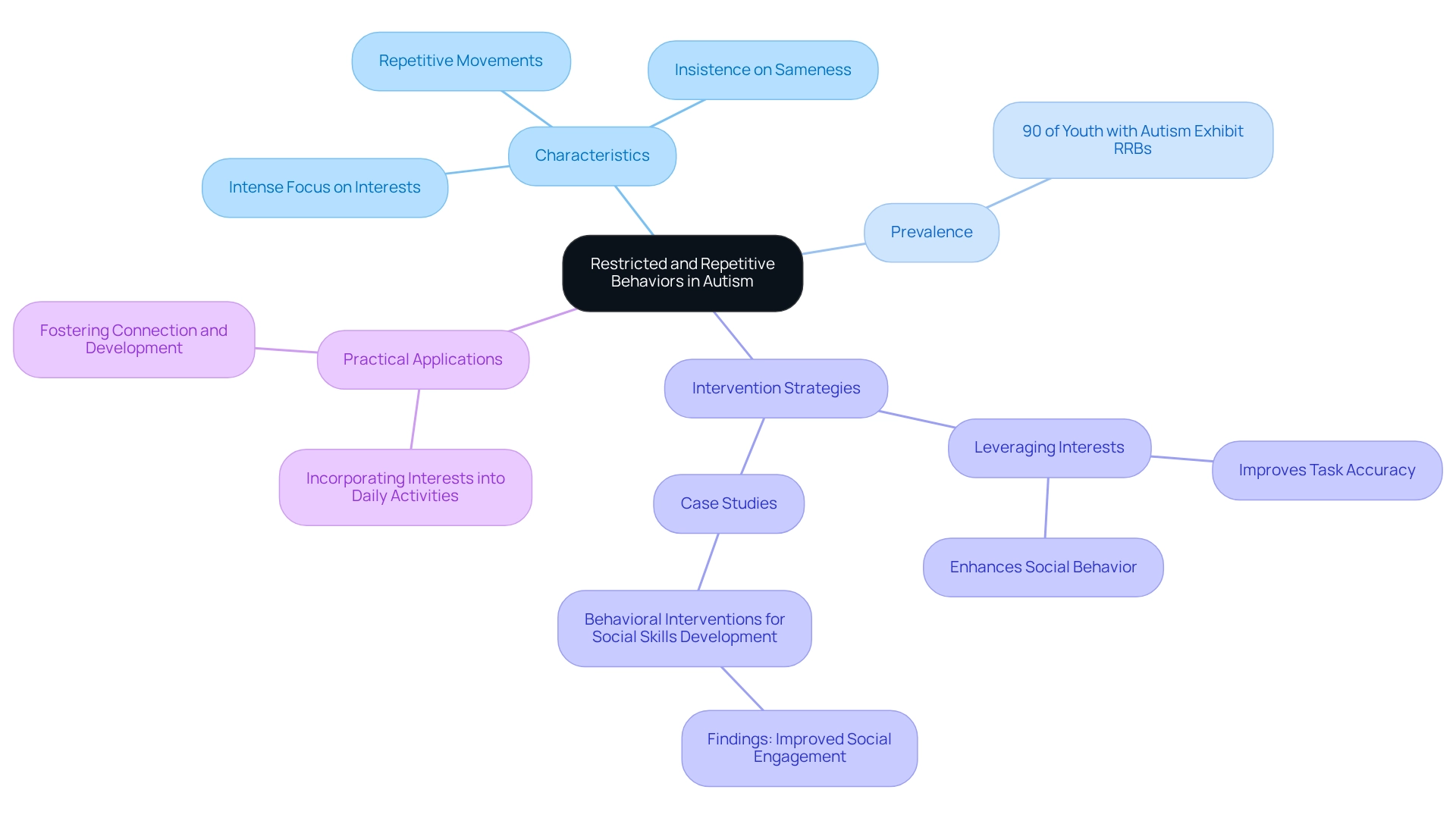
Sensory Processing Differences: Navigating Sensory Challenges in Autism
Processing differences in perception are common among individuals on the spectrum and are indicative of the behaviors of autism, often leading to hypersensitivity or hyposensitivity to various stimuli. For instance, many may feel discomfort in loud environments, have aversions to certain textures, or show a diminished response to pain. A recent study revealed that the behaviors of autism in children manifested as significantly more sensory-related symptoms compared to their typically developing peers, with the ASD cohort's PRI scores being notably lower than those of the SPD and TDC groups. This highlights the unique processing challenges associated with the behaviors of autism they face.
To effectively navigate these perceptual challenges, it is crucial to create supportive environments tailored to the needs of autistic individuals, considering the behaviors of autism. Successful strategies include:
- Establishing quiet spaces for relaxation
- Using noise-canceling headphones in overwhelming settings
- Providing sensory-friendly materials that cater to individual preferences
Occupational therapists emphasize the importance of understanding each individual’s distinct perceptual characteristics, including the behaviors of autism, to make tailored adjustments. As noted by Chang Y-S, "Only ASD individuals will exhibit reduced structural connectivity compared to controls in temporal tracts linked to social-emotional processing," underscoring the neurological basis for these processing challenges.
Statistics indicate that sensitivities are widespread, with many autistic youths expressing unease in daily situations. Research titled 'Group Differences in Sensory Symptoms' found that the group displaying behaviors of autism exhibited notably more perceptual symptoms than the TD group across various subscales, emphasizing the unique processing difficulties faced by youth with behaviors of autism. By recognizing and addressing these perceptual differences, parents can foster a more inclusive and engaging environment, ultimately enhancing their child's comfort and participation in various activities.
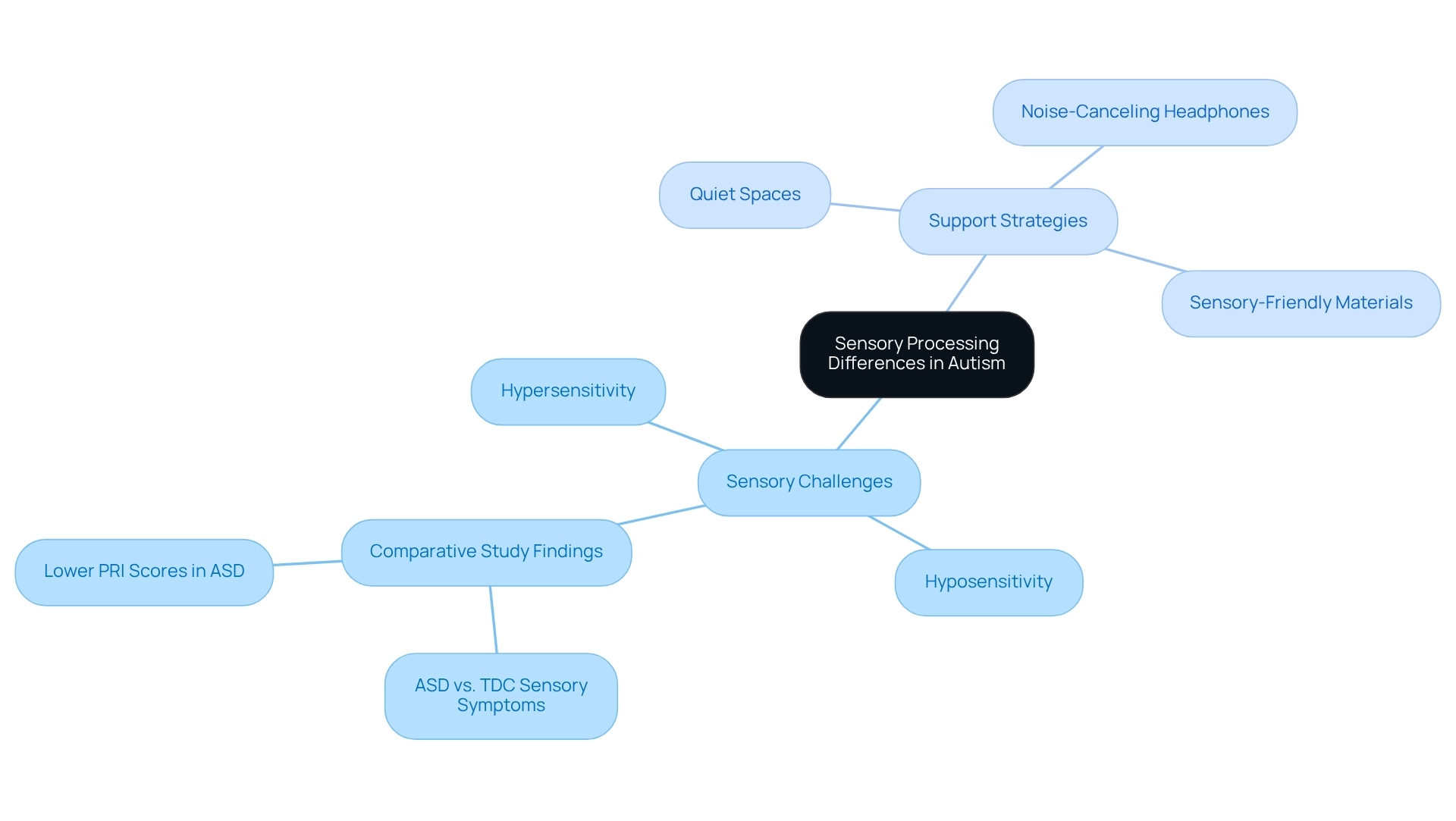
Meltdowns and Emotional Regulation: Understanding Behavioral Responses in Autism
Meltdowns can be incredibly challenging for individuals with autism, as they represent intense emotional responses arising from the behaviors of autism when they feel overwhelmed. Unlike tantrums, these episodes are involuntary reactions triggered by various stressors, such as overwhelming stimuli and disruptions in routine. For caregivers, understanding these triggers is vital in implementing effective prevention strategies. Research indicates that excessive stimulation significantly contributes to meltdowns, as the hyperconnectivity in the brains of autistic individuals affects their behaviors of autism, making them more susceptible to perceptual and emotional overwhelm. Alarmingly, data shows that about 70% of youth with autism exhibit frequent meltdowns, which highlights the prevalence of these behaviors of autism within the community.
To help reduce the frequency of meltdowns, caregivers can adopt several proactive strategies:
- Establish a Tranquil Setting: By minimizing environmental stimuli, individuals can feel more secure and less stressed.
- Use Visual Schedules: Clear visual representations of daily activities can ease transitions and alleviate anxiety related to changes in routine.
- Teach Coping Strategies: Providing children with tools to manage their emotions fosters greater emotional regulation.
A case study on sensory experiences underscores the importance of tailored support strategies in managing the behaviors of autism during meltdowns. This study highlights that understanding the behaviors of autism in response to sensory overload can guide effective interventions.
Moreover, sharing experiences within the ASD Media community can enhance the effectiveness of these strategies, as caregivers learn from one another and collaborate on solutions. Expert insights from behavioral therapists further stress the importance of personalized methods for emotional regulation, particularly in addressing the behaviors of autism, as each individual's needs may differ. By understanding the fundamental reasons behind meltdowns and applying customized support methods, caregivers can significantly improve emotional outcomes for children with developmental disorders, particularly those exhibiting behaviors of autism. This collaborative approach not only enhances personal well-being but also strengthens the community's capacity to support one another in navigating the challenges associated with developmental disorders.
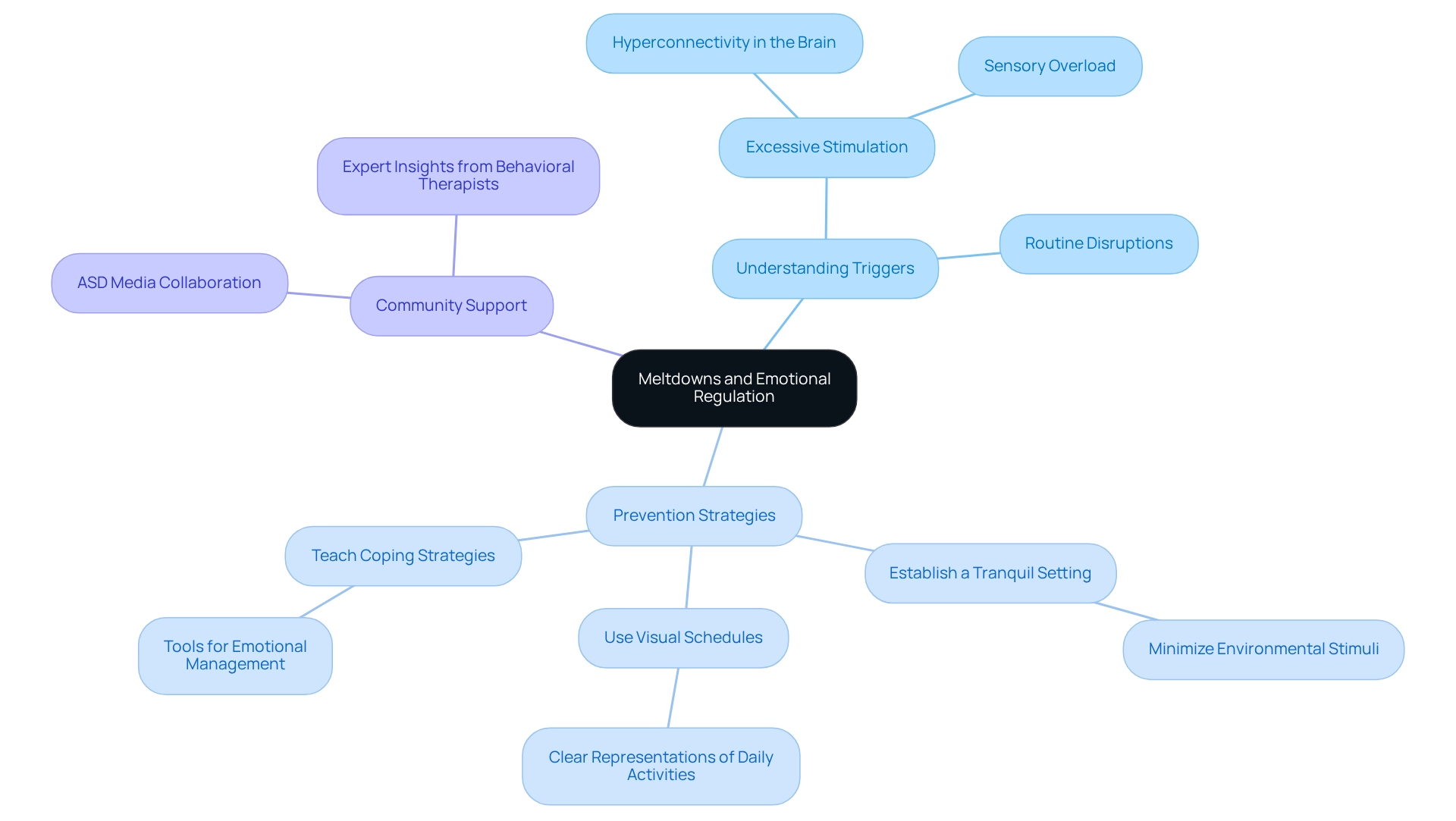
Stimming: Understanding Self-Regulatory Behaviors in Autism
Stimming, or self-stimulatory behavior, includes repetitive actions such as hand-flapping, rocking, or spinning. For individuals on the spectrum, the behaviors of autism serve as vital coping strategies, helping to manage anxiety, express excitement, and provide self-soothing. Research shows that the behaviors of autism, such as stimming, can have positive effects, particularly in lowering anxiety levels among autistic individuals. A study exploring sensory sensitivities and the behaviors of autism revealed that these actions are not merely negative; instead, they can provide significant comfort and regulation for autistic adults. This perspective underscores the importance of understanding stimming as a natural behavior that reflects the behaviors of autism and can enhance emotional well-being.
As we look to 2025, the prevalence of stimming behaviors of autism continues to be significant, with statistics indicating that a considerable portion of the autistic population engages in these behaviors. The occurrence rates of developmental disorders vary by ethnicity:
- Hispanic youth show a rate of 3.12%
- Asian youth at 3.33%
- Other categories reflecting diverse rates as well
Additionally, 57% of families caring for a child with developmental disorders report that a parent has had to reduce or stop employment to meet their child's needs, highlighting the challenges faced by caregivers.
To support individuals who stim, caregivers can create environments that accommodate the behaviors of autism while also introducing alternative coping strategies when needed. Expert insights emphasize the importance of self-regulation for individuals on the spectrum, advocating for a balanced approach that recognizes the behaviors of autism and the role of stimming in emotional regulation. As Ashleigh Evans, a Board Certified Behavior Analyst, shares, "When she’s not working with clients or writing, she can be found chasing her three boys around and exploring outdoors." By fostering an understanding of the behaviors of autism, caregivers can provide better support to autistic individuals in navigating their experiences. Embracing stimming as a natural behavior, while considering alternative coping strategies, can empower both caregivers and individuals on the spectrum.
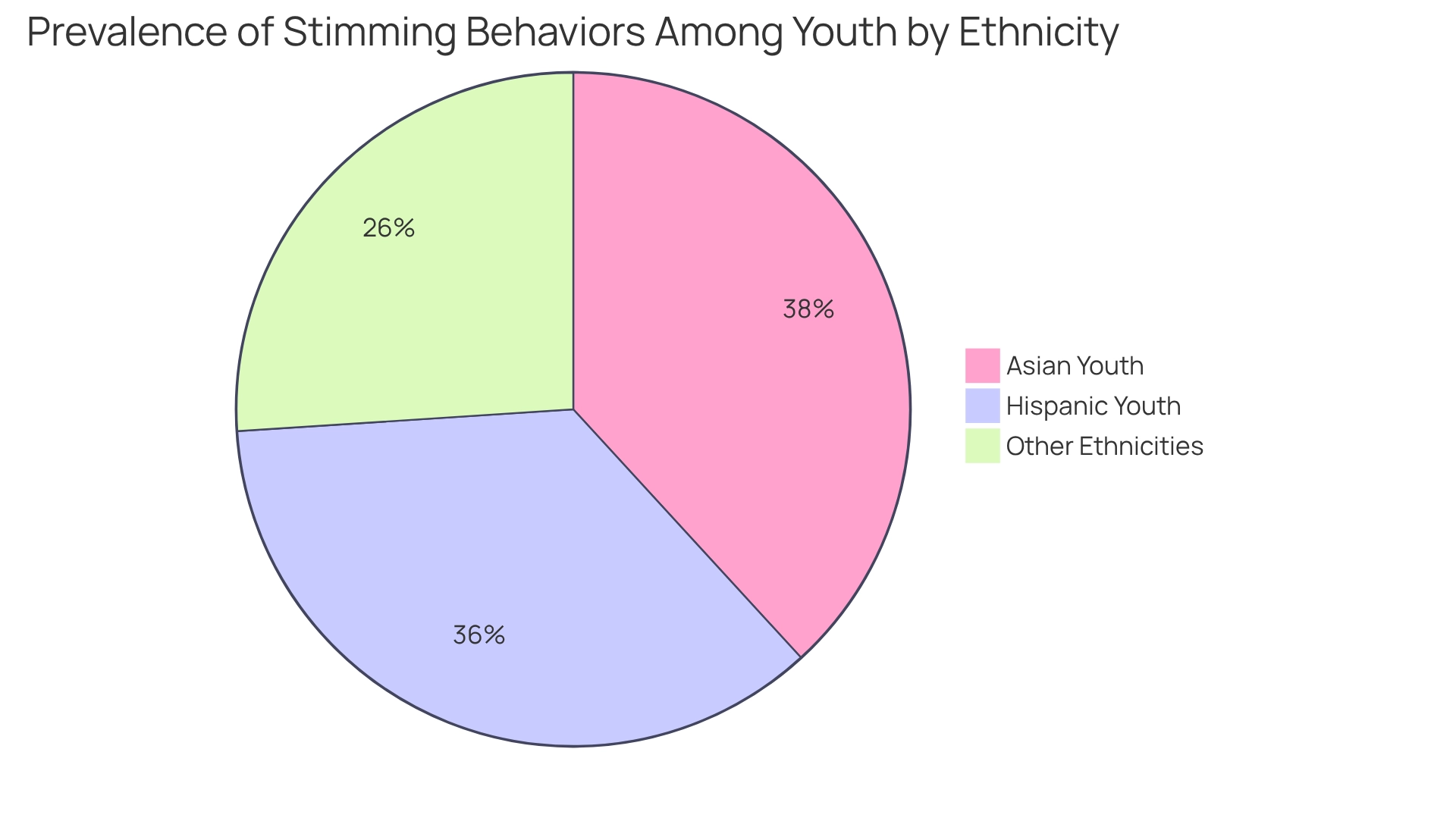
Anxiety-Related Behaviors: Addressing Emotional Challenges in Autism
Anxiety is a common companion to developmental disorders, often intensified by social interactions, sensory overload, or disruptions in routine. It is crucial for parents and caregivers to recognize anxiety-related behaviors—such as avoidance, excessive questioning, and physical agitation—to provide effective support. Did you know that about 40% of children with behaviors of autism face anxiety disorders? This statistic underscores the prevalence of these emotional challenges.
Successful interventions can make a significant difference. For instance, cognitive-behavioral therapy has shown promise in alleviating anxiety symptoms, while mindfulness practices help foster emotional regulation. Establishing predictable routines can also be a source of comfort, offering a sense of security and stability for individuals exhibiting behaviors of autism. As we navigate through 2025, it remains vital to understand and address these emotional hurdles related to the behaviors of autism to enhance the quality of life for autistic individuals and their families.
Customized approaches are being explored, including complementary therapies like CBD, to tackle anxiety and challenging behaviors. This highlights the need for diverse support strategies. Experts emphasize the importance of a nurturing environment that acknowledges the unique behaviors of autism in individuals. Helen Needham beautifully articulates this, stating, "Neurodiversity means understanding what can lead to anxiety and ensuring employees have a network of assistance so that they are not overwhelmed by anxiety, which prevents them from utilizing their strengths effectively." This perspective opens the door to improved outcomes and emotional resilience.
Moreover, resources like the Molehill Mountain app offer tailored support for managing anxiety, featuring mood tracking and self-management advice. These practical tools are invaluable for parents seeking to empower their children. Together, we can create a supportive community that fosters understanding and growth.

Social Skills Deficits: Supporting Interaction and Communication in Autism
Deficits in social skills are a hallmark of autism, often making it challenging for children to build relationships and engage in meaningful interactions, which are influenced by the behaviors of autism. Many individuals may find it difficult to understand social cues, initiate conversations, and maintain eye contact because of the behaviors of autism. With approximately 2.9% of youth diagnosed with autism, addressing the social skills deficits related to the behaviors of autism through effective interventions is vital. Structured social skills training programs have shown promise in improving the behaviors of autism. Techniques such as role-playing scenarios and guided peer interactions can significantly enhance social competence and confidence, addressing the behaviors of autism among autistic individuals.
For example, case studies reveal that targeted social skills training not only improves communication but also helps in managing the behaviors of autism, fostering better peer relationships and ultimately leading to enhanced overall well-being. The document titled 'Public Health Implications of ASD Findings' underscores the need for improved infrastructure to ensure equitable diagnostic, treatment, and support services for all youth with ASD, particularly for non-White individuals and girls.
Experts stress the importance of creating supportive environments where children can practice the behaviors of autism. Parents can play a crucial role by:
- Organizing playdates
- Encouraging participation in group activities
- Providing positive reinforcement
As the CDC notes, "Many individuals on the spectrum have special interests or talents, such as in music, math, or art," which can be leveraged to enrich social interactions and foster connections. By embracing these strategies, we can create a nurturing atmosphere that empowers our children to thrive socially.
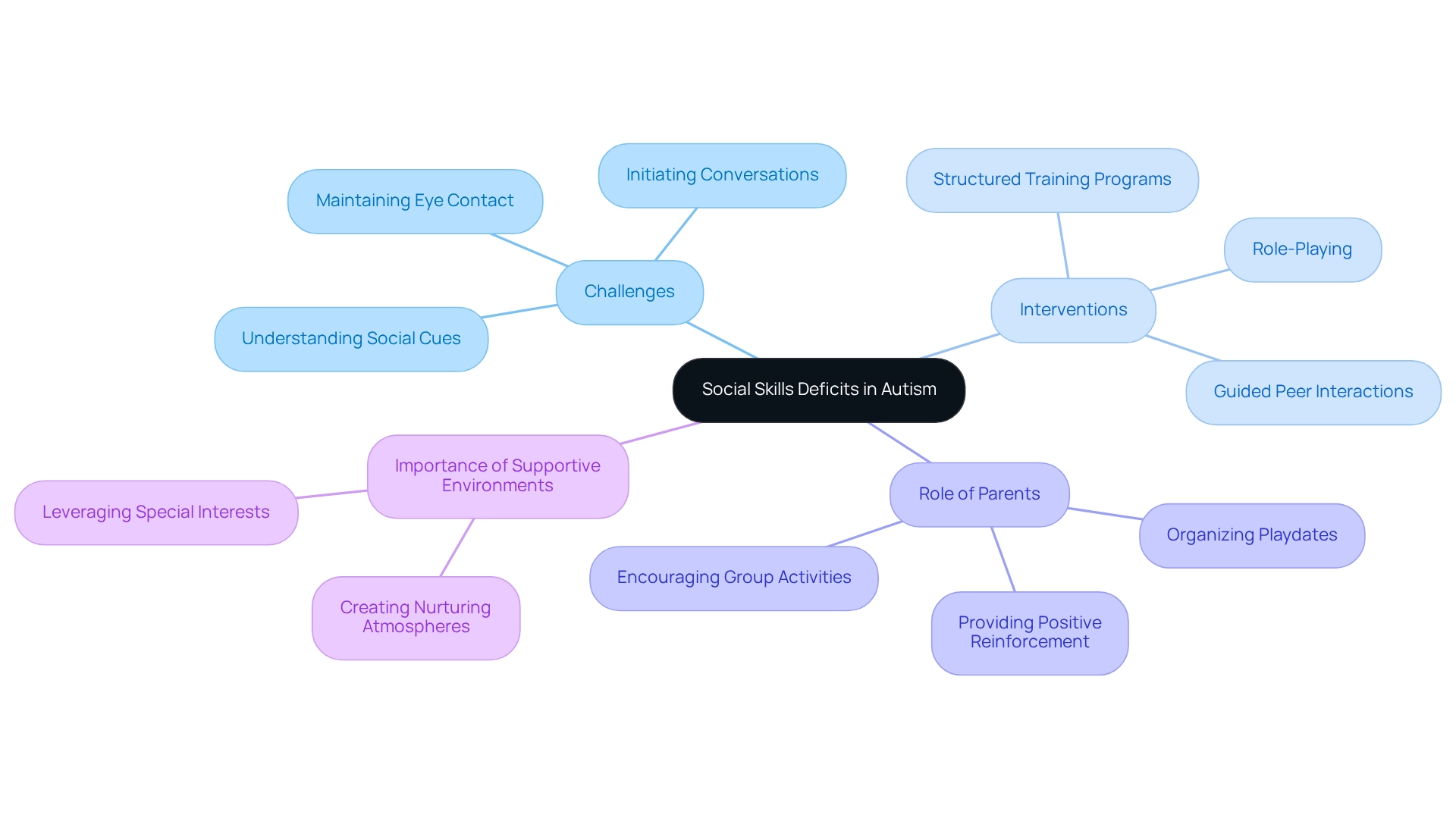
Co-Occurring Conditions: Recognizing Additional Challenges in Autism
Individuals on the autism spectrum often face additional challenges, which may include the behaviors of autism, ADHD, anxiety disorders, and learning disabilities. Recognizing these co-occurring conditions is vital for developing effective intervention strategies. For instance, research indicates that 8% of the ASD population also has diabetes, underscoring the importance of comprehensive health evaluations that consider both physical and mental health aspects.
Moreover, socioeconomic factors significantly impact outcomes for those with ASD. Studies reveal a correlation between socioeconomic status and the prevalence of psychiatric disorders among individuals on the spectrum. This highlights the necessity of integrating these factors into treatment and support services.
To truly meet the unique needs of each child, thorough evaluations and personalized care plans are essential. Developmental specialists, like Dr. Connor Kerns, emphasize that understanding the interplay between neurodevelopmental disorders and co-occurring conditions, including the behaviors of autism, as well as the effects of childhood adversities and trauma on mental health, can lead to more tailored interventions. Successful strategies often embrace a multidisciplinary approach, combining behavioral therapies with support for mental health and learning challenges.
By focusing on the holistic development of young individuals with developmental disorders and acknowledging the specific challenges they face, caregivers and professionals can foster better outcomes and enhance overall well-being. Together, we can create a supportive environment that nurtures growth and resilience.
Early Diagnosis and Intervention: Key to Supporting Autism Behaviors
Timely detection and intervention are vital for young individuals with developmental disorders, significantly influencing their long-term outcomes in communication, social skills, and emotional regulation. Research indicates that children who receive early intervention are less likely to require support services later in life and are more inclined to thrive in mainstream education and employment settings.
As parents, it’s essential to recognize the early signs of autism and the behaviors of autism, seeking evaluations from qualified professionals without delay when concerns arise. By implementing evidence-based interventions early on, we can profoundly enhance a child's development and overall quality of life, particularly by addressing the behaviors of autism.
Consider this: statistics reveal that 50% of autistic youth in the U.S. who participate in vocational rehabilitation services begin these programs during high school. This highlights the critical importance of early intervention in facilitating access to services addressing the behaviors of autism.
Moreover, while the average cost of therapeutic behavioral services hovers around $175.44, investing in early intervention can lead to significant long-term savings by reducing the need for more extensive support later on, particularly in addressing the behaviors of autism. By prioritizing early diagnosis and intervention, you can unlock your child's potential and pave the way for a brighter future.
As noted by the U.S. Department of Education, 8% of autistic students in the U.S. do not complete high school, compared to 5% of all students. This underscores the importance of timely support in enhancing educational outcomes. Together, let’s ensure our children receive the support they need to thrive.
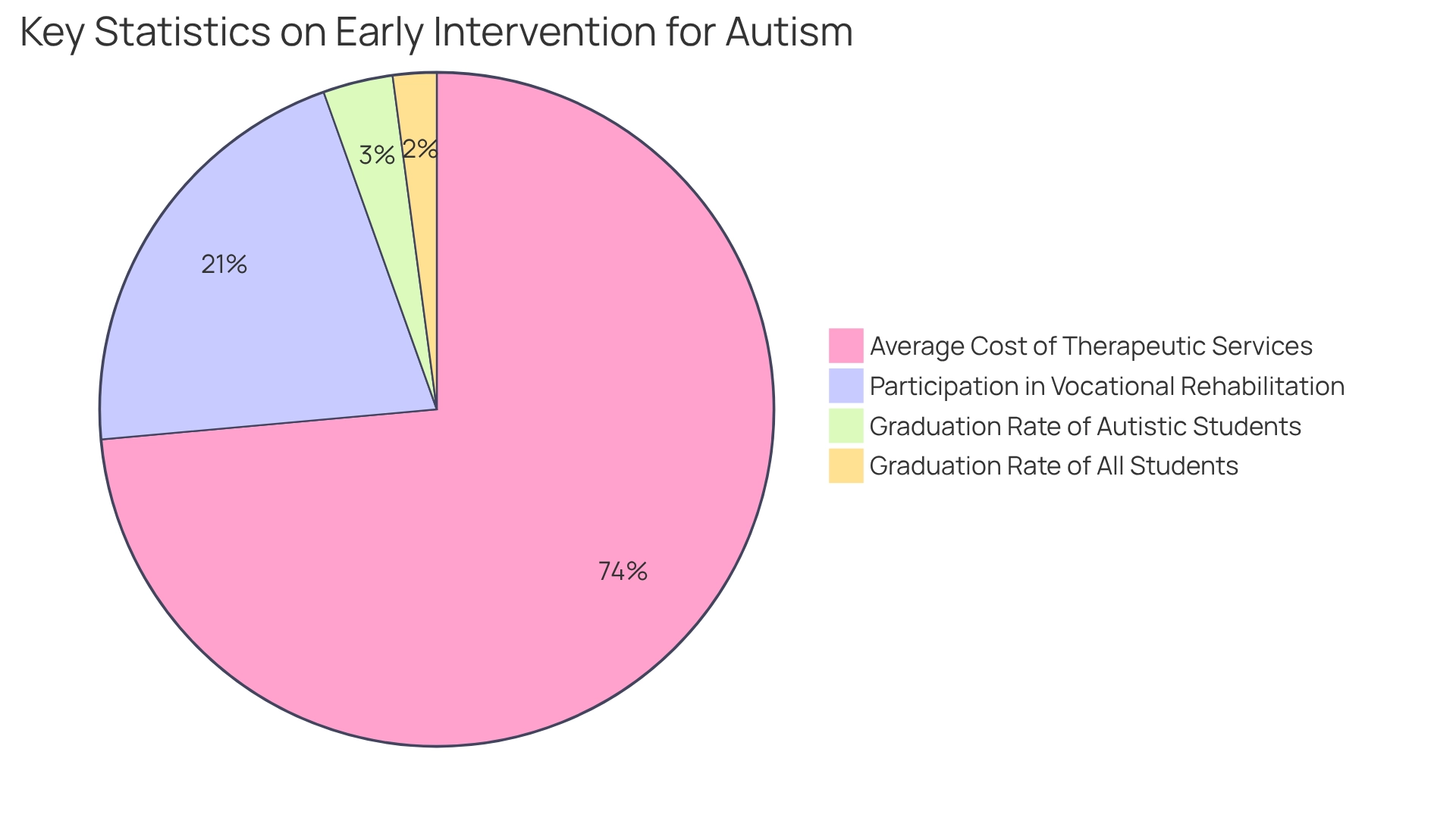
Conclusion
Navigating the complexities of autism can feel overwhelming, but a comprehensive understanding of its characteristics and the resources available can make a significant difference for individuals and their families. ASD Media emerges as a vital ally, offering a diverse array of tools designed to empower parents and professionals alike. From informative articles to community forums, these resources help demystify challenges such as social communication difficulties, sensory processing differences, and the emotional responses often associated with autism.
Recognizing key indicators of autism—like restricted and repetitive behaviors or anxiety-related issues—is essential for timely intervention. By implementing personalized strategies and cultivating supportive environments, caregivers can greatly enhance developmental outcomes for children on the spectrum. Moreover, understanding the role of stimming and emotional regulation sheds light on the self-regulatory behaviors that are frequently misunderstood.
The significance of early diagnosis and intervention cannot be overstated. Engaging with resources like ASD Media empowers families to address challenges proactively, leading to improved social skills, emotional well-being, and overall quality of life. By fostering a community of support and sharing experiences, caregivers can unite to navigate the unique challenges of autism, ensuring that individuals with ASD receive the understanding and resources they need to thrive.
In conclusion, while the journey through autism can be complex, it is navigable with the right support and resources. By prioritizing education, early intervention, and community engagement, families can empower their children to reach their full potential, transforming challenges into opportunities for growth and development. Together, we can create a brighter future for those on the spectrum.
Frequently Asked Questions
What resources does ASD Media offer for parents and professionals navigating autism?
ASD Media provides a variety of resources including informative articles, engaging webinars, and supportive community forums to help explore the behaviors of autism and effective intervention strategies.
What is the significance of the statistic that 1 in 6 youths aged 3–17 years were identified with a developmental disability from 2009 to 2017?
This statistic highlights the urgent need for accessible information and support for families and professionals dealing with developmental disabilities, including autism.
How prevalent is Autism Spectrum Disorder (ASD) among 8-year-olds according to CDC data?
The occurrence of Autism Spectrum Disorder among 8-year-olds is 27.6 per 1,000 youths, with boys being significantly more affected than girls.
What role do community forums play in supporting families dealing with autism?
Community forums provide peer assistance, allowing parents to share experiences and solutions, which enhances their ability to navigate autism-related issues.
What are some key indicators of autism that parents should recognize?
Key indicators include limited eye contact, difficulty interpreting facial expressions, and challenges in initiating or responding to social interactions.
What percentage of young individuals with developmental disorders experience social communication challenges?
Approximately 70% of young individuals with developmental disorders face some form of social communication challenges.
What are restricted and repetitive behaviors (RRBs) in autism?
RRBs are defining characteristics of autism spectrum disorder, including repetitive movements, insistence on sameness, and intense focus on specific interests.
How common are RRBs among youth with autism?
RRBs are prevalent in roughly 90% of youth with autism.
How can parents use their child's interests to support development?
Parents can observe their children's interests and incorporate them into daily activities, which can create opportunities for engagement and reduce the intensity of RRBs.
What is the importance of personalized intervention strategies for individuals with autism?
Personalized intervention strategies are crucial as they cater to the unique characteristics and needs of individuals with autism, enhancing their social engagement and overall development.




